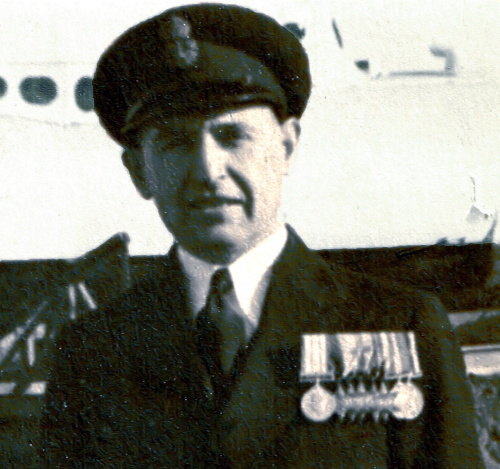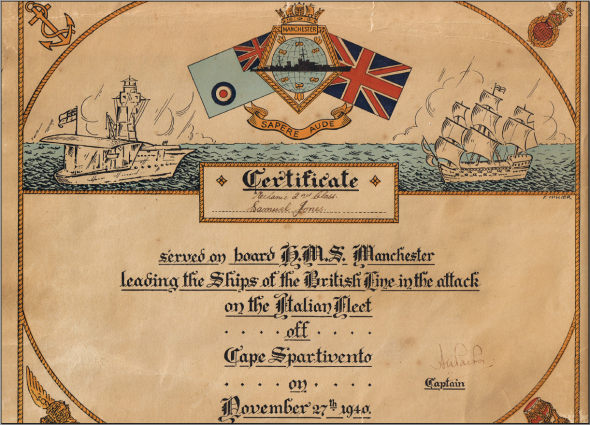

The Early Years
Sam was born in Brown Hills on 9th January 1909. His mother was Florence who lived in Allbutt Road. His father, John Jones worked as a coal miner in the local pit.
Service Record:
30th August 1927 - Enlisted as Stoker 2nd Class for a 12 year engagement.
His previous occupation was that of a miner.
HMS Victory - Royal Naval Barracks and Base Portsmouth
2nd January 1928 - HMS Renown - Battlecruiser.- Battlecruiser Squadron Atlantic Fleet
14th May - 1929 - HMS Victory
18th December 31st March -1929 - HMS Fisgard - Training Ship Portsmouth 1931 - HMS Victory
2nd June - 1931 - Books of HMS Victory but aboard HMS Boadicea on first commissioning.
18th July 1931 - Books of HMS Egmont II - Naval Base Maita serving aboard HMS Boadicea a unit of the 4th Destroyer Flotilla, Mediterranean Fleet
1st Jul 1933 - As last but borne on the books of HMS St Angelo II - (HMS Egmont II was re- named)
23 Aug 1933 - Books of HMS Victory - still aboard HMS Boadicea
2nd Oct 1933 - HMS Victory
16 Apr 1935 - HMS Ajax- Cruiser-America & West Indies Station but at some time transferred to Mediterranean to serve off Palestine - hence Naval General Service Medal with Palestine clasp 1936-1939.
18th Sept 1937 • HMS Victory
2nd December 1937 - Re-engaged for 9 years to complete time to pension. Now described as being 5 feet 3 ½ inches in height with fair hair, blue eyes and of fresh complexion
1st January 1938 - HMS Drake - RNB and Base Devonport
9th September 13th December 1939 - HMS Victory
1939 - HMS Manchester - Light Cruiser.
Early 1940 - Home Fleet at Scapa Flow- Northern Patrol duties 21st February 1940 - Captured German merchantman ' Wahehe'. (NB She was taken over and renamed Empire Citizen and sunk by U-107 3rd February 1941)
April 1940 - Norwegian Campaign
15th September 1940 - Sailed for Mediterranean
27th November 1940 - Participated in the Battle of Cape Spartivento -an action against an Italian Cruiser Squadron
13th December 1940 - Retums to UK and refitting for 4 months.
May 1941- Patrolling Iceland-Faeroes passage searching for the Bismarck
July 1941- Returns to the Mediterranean
23rd July 1941 Samuel is injured by blast from a torpedo explosion (Hurt Certificate Granted) when she is hit on the port quarter by an aerial torpedo following an attack by Italian aircraft whilst off Bone during Operation Substance - a supply convoy from Gibraltar to Malta.
His grandson tells us that ' he was in the engine room when the torpedo struck. He didn't remember much except that his body was recovered and laid out on the deck along with all the other dead casualties, when a mate identified him, covered from head to toe in oil and shook him and he regained consciousness.
HMS Manchester was part of the Home Fleet and was acting as reinforcement units deployed to assist units of the Mediterranean Fleet.
Temporary repairs carried out at Gibraltar and Manchester then sailed to
Philadelphia for full repairs.
27th February 1942 sailed for Portsmouth to effect final work ofrepair which was completed by the end of April.
1942 - HMS Victory
1942 - HMS Scylla - Light Cruiser - fitting out, commissioning and working up.
9th September to 20th September 1942.1st Operation - Flagship of the Fighting Destroyer Escort (FDE) commanded by Rear Admiral R. Burnett- Convoy PQ18 to Russia & QP14 home bound
9 Merchant ships were lost on PQ18 and 4 on the return QP14 in addition to 2 escorts. A summary of what happened in the big attack is taken from an illustrated lecture given by David Slade whose father Leslie Slade was aboard Scylla and viewing the proceedings from his action station in the open port porn-porn director situated just below the bridge.
Sunday 13th September on which the events were such that they would remain indelibly imprinted on my father's memory until the day he died.
To begin with the first air attack took place at 15 .00 hours, when 6 Ju88's were beaten off without loss.
However half an hour later, some 30 Ju88's together with 55 He 111's, all armed with torpedoes, made a determined attack using what the enemy called a "Golden Comb Technique". Some reports indicate even more aircraft than this took part in the attack - a thought that makes what follows more awesome still. The planes made their approach in perfect formation, in line abreast, some I 00- 150 yards apart and at a height of35 feet with intention of dropping their torpedoes simultaneously. This they did, notwithstanding the AA fire from the defenders and the Sea-Hurricane fighters launched from HMS Avenger.
Try to imagine the scene if you can. Every ship in the convoy was firing every available gun at targets flying at 35 feet. At least 85 German aircraft were returning fire. Sea-Hurricanes were following their targets into the shipping lanes, their guns blazing. Ships were being hit by friendly fire. The noise was deafening and in midst of this the Convoy Commodore was confronted with at least 85 torpedoes racing towards him and the ships he was responsible for.
He signalled an emergency turn. This was complied with by all but those in most danger - the starboard two columns. They either didn't see the signal or misunderstood it.
The result was that 6 of the remaining 7 ships in the starboard column were hit and only the ammunition ship, Mary Luckenbeck, in the column survived. In addition two ships in the second column were also hit and lost.
It was all over in 13 minutes. For most it was the longest 13 minutes of their lives, for some it was the last 13 minutes.
Later that day Scylla hove to so that some 221 survivors from the ships that had been sunk could be transferred to her, thus saving them from a long, cold and dangerous period in prefabricated huts should they reach Murmansk. There were no survivors from the Empire Stevenson.
Meantime the air attacks continued and two were beaten off without loss during what remained of the day.'
They were cheered into Harbour at Scapa Flow and later Winston Churchill came aboard to address the crew.
November 1942 - To the Mediterranean to support Operation Torch 8th November 1942 - Supporting the Landings in North Africa.
10th November 1942 Rescues survivors from the sloop HMS Ibis sunk by Aircraft.
P.O.Les Slade is one of those to volunteer to carry out artificial respiration on those rescued apparently dead. He worked on the Ibis' Lt Cdr for over an hour without success.
1st January 1943 Intercepted and sank the German Blockade Runner Rhakotis 200 nautical miles NW of Cape Finisterre
21st February to 10th March 1943 Russian Convoy JW53 and RA53 homebound - in which they experienced the worst weather of all the Convoys to Russia. This bad weather prevented the enemy finding JW53 until 23rd February when unsuccessful aircraft and U-boat attacks took place. On the return RA53 Convoy 2 ships were lost to U-boats and one foundered in heavy weather
King George V1 came aboard on their return and remained aboard for the voyage from Scapa Flow to Thurso.
April - August 1943 - UK to Gibraltar Convoys crossing the Bay of Biscay on a Gibraltar Convoy.
9th September 1943 Landings on the Italian Mainland at Salerno-Mount Etna erupting in the background. Near missed - engine damage.
Returns to UK for repairs and Sam is drafted away from Scylla.
7th Oct 1943 - HMS Victory
19th Nov 1943 - Books of HMS Boscawen - Naval Base at Portland - serving aboard HMS Ross an elderly Hunt Class Minesweeper.- Seems probable that she was involved in the D-Day Landings as Samuel qualified for the France & Germany clasp which is indicative of participation aboard a ship which was present in some capacity. Sweeping ahead of the Invasion Fleet or in the succeeding days most probably in this case.
1st Jan 1945 -Books of HMS Lucifer-Naval Base at Swansea- still serving on HMS Ross
15th Jan 1945 - HMS Victory
22nd Feb 1945 - HMS Cleopatra - Cruiser - sailed to the East Indies.
September 1945 - First ship into the newly surrendered Singapore 1945/46 5th Cruiser Squadron - East Indies
7th February 1946 - Returned to Portsmouth to refit and thereafter 2nd Cruiser Squadron Home Fleet
1946 - Paid £25 to re-engage for Supplementary Service 1947 - HMS Victory
1947 - HMS Illustrious - Aircraft Carrier - Used for trials
January - August 1948 - Refitting and modernising.
10th Nov 1948 - HMS Implacable - Aircraft Carrier
1948-49 Deck landing training ship
1950 - An operational carrier once again.
5th May 1950 - HMS Victory
27th May 1950 - HMS Hornet - Coastal Forces Base at Gosport - Engaged in refitting Motor Torpedo Boat's
21 Apr 1953 - HMS Victory
11 Aug 1953 - Released as time expired.
Promotions
1927 - Stoker 2nd Class 1928 - Stoker 1st Class
1933 - Acting Leading Stoker 1934 - Leading Stoker
1936 - Acting Stoker Petty Officer
1937 - Stoker Petty Officer 1939 - Mechan.ician 2nd Class 1941 - Mechanician 1st Class
1944 - Chief Mechanician (Temporary) 1945 - ChiefMechanician (Permanent)
